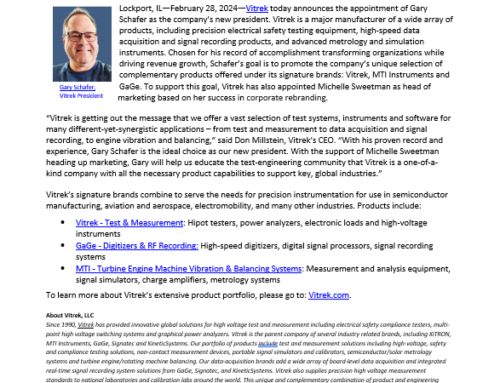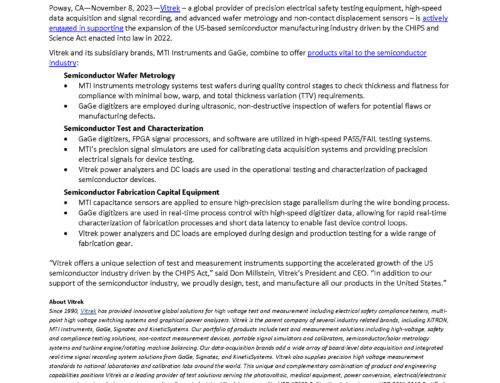

Ground-Breaking Lightning Study Uses GaGe Razor Express High-Speed Digitizer
By Gerald Allgaier, GaGe (a Vitrek brand)

Introduction
Razor Express digitizer is an integral part of VHF broadband interferometer designed to investigate high-energy radiation from lightning strikes and multi-stroke positive cloud-to-ground flashes.
A doctoral dissertation published in 2022 by Michelle Urbani, a PhD candidate at the Universitat Politècnica de Catalunya BarcelonaTech describes the development of a VHF broadband interferometer to investigate and better understand unsolved lightning phenomena [1].
Very high frequency (VHF) is the International Telecommunication Union (ITU) designation for radio frequency electromagnetic waves that occur within a frequency range of 30 MHz to 300 MHz and a wavelength range of 10 meters to 1 meter. A VHF broadband interferometer is a system used to locate sources
of radiation events at VHF band by extracting the differences of phases at various frequency components of Fourier spectra between a pair of antennas.
For this study, the interferometer was designed to measure the electric field of lightning discharges in the VHF band with the paper describing its design and implementation, its calibration and testing in the field, and concluding that that the developed system can measure the electric field of lightning discharges in
the VHF band with high accuracy.
This article highlights the use of the GaGe Razor Express 16-bit PCIe digitizer as part of the developed system utilized to capture the high-speed lightning events that contributed to the successful project.
VHF Broadband Interferometer Development
The following paragraphs from the dissertation introduction nicely summarizes the application and the purpose of a VHF broadband interferometer:
Despite being one of the most fascinating phenomena of nature, lightning still has many unresolved aspects and open questions. Beyond the purely scientific interest, it is absolutely relevant to understand lightning for protection reasons. Lightning plays an important role in the dynamics of our atmosphere and has a major impact on our society and economy, causing a lot of damage to buildings, tall structures (like wind turbines), aircraft and electronics. Lightning strikes can initiate wildfires and especially causing loss of human lives.
Lightning is a complex phenomenon which involves physical processes with different temporal and spatial scale. Currently, it is still not fully understood their initiation and the mechanism able to produce the charge separation which produce the high potential difference needed for lighting propagation. Another crucial issue is the charge polarity asymmetry. Positive lightning has different characteristics and behavior than negative lightning, and this diversity results in the occurrence of different physical phenomena.
A VHF broadband interferometer is a specialized instrument for investigating lightning phenomena. It has a very high temporal resolution, at least one order of magnitude higher than other lightning detection networks with remote sensors, and its strength is the capability to resolve in detail leader channels and breakdown discharges even inside the cloud. If it is configured to acquire data in coincidence with other detectors or measuring instruments (like high-energy detectors, fast electric field antenna, photometers or high-speed camera), which add complementary information, this powerful instrument provides the lightning VHF mapping and flash development at the time of simultaneous detections. The combined information from a multi-instrument installation allows us to better depict lightning phenomena and make progress in their understanding with new scientific findings.

Figure 1: VHF broadband interferometer measurement technique used to map lightning leader propagation while X-ray emissions are captured by a high-energy detector. Three VHF antennas are used (denoted by the oval symbols) for capture.
Two lightning interferometers were developed by the research team to lead the investigation. The instruments can map lightning discharges by correlating the signals from the system’s antennas. Using the geometrical deployment of the antenna, the interferometry technique enables the location of the point source by calculating the phase differences between the interference fringes.
The signals from the three antennas of the interferometer acquire very high frequency VHF radiation (30 – 300 MHz). The signals are bandpass-filtered (20 – 80 MHz), preamplified and connected via high-quality coaxial cables to the GaGe Razor Express 4-channel, 16-bit resolution PCIe digitizer with a sampling rate of 200 MS/s per channel and 8 GB of onboard memory. The Razor PCIe digitizer card is integrated into a PC workstation with its PCIe interface allowing for real-time high-speed streaming transfers of the acquired data for analysis.
The 16-Bit Digitizer Used in the VHF Broadbank Interferometer System
The measurement challenges of this advanced lightning study required the ability to digitize high frequency events with sufficient bandwidth and sampling rate to enable the accurate mapping of lightning discharges using cross correlation of phase shift data from the multiple antennas. This was the ideal situation for selection of the multi-channel GaGe Razor Express 16-bit PCIe Digitizer (Figure 2).
The four channel inputs of the Razor digitizer allowed for the connection of three VHF antennas for digitizing VHF data ranging from 30 to 300 MHz and one E-field plate antenna connection whose signal serves as the trigger event source for capture. The high 125 MHz of analog input bandwidth of the channel inputs of the Razor digitizer is sufficient to capture the bandpass-filtered (20 – 80 MHz) and preamplified signal outputs from the connected VHF antennas.
Utilizing the Razor PCIe digitizer eXpert streaming capability allowed the researchers to simultaneously acquire and stream the data for signal recording in real-time for analysis with multi-triggered based operations as noted:
In order to maximize the chance to record interesting events, we developed the acquisition system software to get a continuous recording in streaming mode, filling a circular buffer in the RAM memory. We set our acquisition time duration at 2.5 s with 0.5 s of pre-trigger and less than 20s of dead time after the triggered event. Both interferometers were online and could be turned on remotely when a storm was approaching. Once activated, the acquisition system can be triggered by an E-field flat plate antenna installed nearby. The flat-plate antenna measures the environmental electric field along the vertical axis. The nominal calibration of the antenna is 16 kV/m on output volt with a time constant of 1 s. The E-field signal was acquired in the 4th channel of the GaGe digitizer.

Figure 2. The 4-Channel GaGe Razor Express PCIe digitizer provides the input from the three
antennas and the E-field input for the VHF broadband interferometer system.
- GaGe high-performance digitizers are renowned for sustaining the maximum effective number of bits (ENOB) over a wide signal frequency range with quality signal conditioning and signal fidelity features.
- The GaGe Razor Express PCIe digitizer features 16-bit resolution with true Effective Number of Bits (ENOB) up to 11.7-bits.
- The four-channel model used in this application supports a maximum A/D sampling rate of 200 MS/s per channel. It supports 17 software selectable A/D sampling rates ranging from 1 kS/s to 200 MS/s. The analog input bandwidth is 125 MHz per channel. The input channels are software selectable for AC / DC coupling and 50 Ω /1M Ω Inputs. Onboard auto-calibration provides DC accuracy of ±0.5%.
- The Razor Express includes 8 GB of onboard acquisition sample memory. The onboard acquisition memory size is shared and equally divided between the channels when acquiring data to onboard memory.
- With the optional eXpert PCIe Data Streaming FPGA Firmware package, the dual-port architecture of the onboard memory is utilized as a large FIFO buffer for streaming acquired data to host PC memory via the digitizer’s PCIe Gen2 x8 interface at real-time sustained rates up to 1.6 GB/s supporting the full 200 MS/s per channel for all four channels. This streaming mode can be effectively utilized to conduct real-time sustained host-based signal processing and/or signal recording operations of the acquired data.
[1] Urbani, Michele. Development of a VHF broadband interferometer to investigate unsolved lightning phenomena: high-energy radiation from lightning strikes and multi-stroke positive cloud-to-ground flashes. 2022. Universitat Politècnica de Catalunya BarcelonaTech, PhD electrical engineering dissertation.



